Diplomacy Works Part II
Here are more stories about the day-to-day work U.S. diplomats do around the globe to advance American ideals, protect America’s prosperity and national security and help maintain a peaceful world.
U.S. diplomacy is vital to American prosperity and national security and to maintaining a peaceful world.
As part of AFSA’s mission to tell the story of the Foreign Service, The Foreign Service Journal is building a collection of narrative “case studies” written by active-duty and retired members of the U.S. Foreign Service. These accounts show the indispensable everyday work of career diplomats and development professionals around the world. Part I was published in the December Journal, and here we bring you Part II.
Members of the FS community: We know you have great experiences to add to this collection. Please submit your 500- to 800-word stories to journal@afsa.org, with the subject line “Diplomacy Works.”
—The Editors
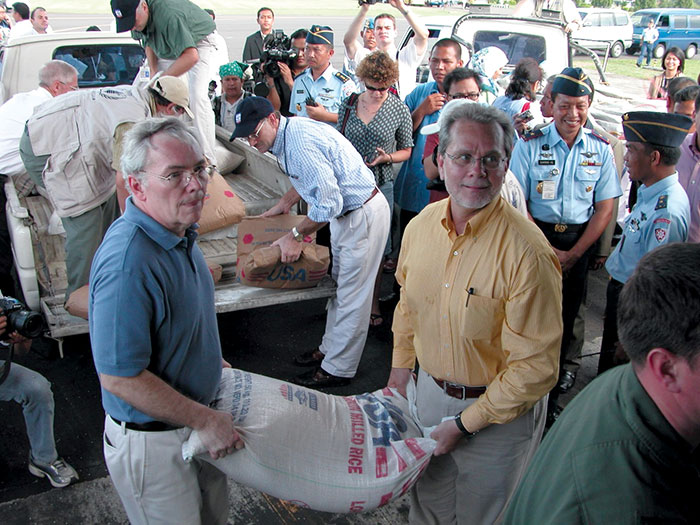
Ambassador B. Lynn Pascoe, at left, and USAID Director William M. Frej load supplies for Aceh.
Courtesy of B. Lynn Pascoe
Post-Tsunami Assistance in Aceh: Changing a Relationship
INDONESIA, 2004 • B. LYNN PASCOE

An Acehnese woman showing appreciation for the U.S. military (primarily Navy and Marine) effort to aid the tsunami’s victims.
Courtesy of B. Lynn Pascoe
On a sunny morning on Dec. 26, 2004, a gigantic, 9.1-magnitude earthquake unleashed a terrible tsunami that swept the shores of Indonesia’s rebellious, deeply religious and isolated province of Aceh, killing at least 170,000 people and injuring tens of thousands more. Foreigners were barred from the province, and we only began to understand the enormity of the tragedy after Indonesia’s new President Susilo Bambang Yudhoyono (known as SBY) visited the next day.
When Indonesian Vice President Jusuf Kalla assembled international representatives to plead for help, I asked him privately what was most needed from the United States. His answer: helicopters. I called Commander in Chief of the U.S. Pacific Fleet Admiral Tom Fargo, who said he had ordered the carrier USS Abraham Lincoln with its 17 helicopters to move south from Hong Kong. We agreed to ask Washington to send it to Aceh.
SBY made two crucial early decisions: He told the army to quit fighting the rebels, and he agreed to allow the U.S. carrier to be positioned off Indonesia’s coast. Only a former top general such as SBY could have convinced the Indonesian military to stop that long internal war. Moreover the Indonesian military deeply resented the United States because of our embargo on bilateral cooperation and weapon sales in response to its atrocities in Timor-Leste. The Indonesian civilian population had also expressed a low opinion of the United States through massive demonstrations against our invasion of Iraq, and terrorists had added to the tensions by bombing the JW Marriott Hotel Jakarta a year earlier.
The embassy notified Washington that we planned to use $65 million in unobligated Indonesian aid funds (as well as a $100,000 contingency fund) for disaster relief. Washington quickly agreed. Our USAID staff began organizing relief convoys from our consulate in Medan, the capital of North Sumatra province. The first convoy was turned back by rebel fire, but it got through a day later. Our attaché office flew Indonesian military personnel on reconnaissance missions, and doctors from the embassy’s Naval Medical Research Unit were soon on the ground in Aceh saving lives.
As the Lincoln neared Indonesia, its commander, Admiral Doug Crowder, and I agreed over the phone on the modalities of the assistance effort. At noon on New Year’s Day 2005, the carrier began its helicopter rescue missions. Several U.S. C-130s had arrived in Jakarta to haul supplies to Aceh; the American Chamber of Commerce in Jakarta and USAID staff had lined up trucks of critical items; and members of the embassy joined in to help load the planes.
I held a press conference to reassure the Indonesian public that we were there only to support their government and to help the people of Aceh. The comments were widely reported, along with a picture of USAID Director Bill Frej and me hefting a bag of rice onto an American C-130. One of Crowder’s pilots took the advice of an embassy liaison staffer and put a U.S. journalist, CNN’s Mike Chinoy, and his cameraman on a relief helicopter. Chinoy’s reporting was among the first to bring the enormity of Aceh’s disaster to the world’s attention and included the iconic picture of locals running to greet the American helicopter as they sought desperately needed water and medical assistance.
This kind of quick thinking was shown repeatedly by the American team. One example was water for the survivors: During our initial meeting with the Marine general leading the overall U.S. effort, Frej noted that the need for water was crowding out other critical relief supplies being sent to Aceh on our planes. When he replied that the carrier could produce vast amounts of potable water, Frej promised to have every new plastic container they could buy in Jakarta on that afternoon’s plane. The ship’s engineers created an ingenious jerry-rigged system to fill the containers overnight, and the water was on the helicopters the next morning. Everyone pitched in.
The assistance to Aceh was a massive international effort: with our support, the Indonesian government put a new (non-corrupt) agency in charge of relief and reconstruction. Governments and private citizens donated money—more than $1 billion in private U.S. contributions encouraged by the efforts of former presidents George H.W. Bush and Bill Clinton and $500 million from the U.S. government. The Lincoln was replaced after a month by the Navy’s hospital ship USS Mercy, staffed with Project Hope volunteers—an idea of Deputy Secretary of Defense (and former ambassador to Indonesia) Paul Wolfowitz.
Indonesian public opinion quickly shifted. The people knew that Americans were with them from the first, not to score points, but to help fellow human beings in desperate straits. They expressed their appreciation in many ways, including in public opinion polls that consistently showed that Indonesians held the United States in higher esteem than did any other Muslim-majority country.
B. Lynn Pascoe served as U.S. ambassador to Indonesia from October 2004 to February 2007. During almost four decades in the Foreign Service, he also served as ambassador to Malaysia and worked in various positions dealing with China and the former Soviet Union. Amb. Pascoe retired to become United Nations undersecretary-general for political affairs, a position he held for more than five years.
Strong Institutions, Not Strongmen
AFRICA, 2013 • JASON H. GREEN
Rarely in the life of a Foreign Service public affairs officer (PAO) will colleagues from across one region have the opportunity to collaborate with each other, and with Washington interagency officials, to advance a specific policy objective. With guidance from leadership in the State Department’s Bureau of African Affairs and the White House, Africa-based PAOs had such an opportunity in 2013 as they faced the challenge of successfully facilitating the development of judicial institutions on that continent.
Strengthening democratic institutions is a key State Department policy pillar across sub-Saharan Africa. However, the U.S. government has traditionally given less attention to the judiciary than to the executive and legislative branches, even though courts make or change law as much or more than the other two branches of government. High courts across the African continent suffer from undue executive influence, lack of expertise in thematic areas of law, and massive case backlogs resulting from poor case and court management.
In 2013, the Bureau of African Affairs, the Office of Public Diplomacy and Public Affairs and the Bureau of Educational and Cultural Affairs worked with 20 embassies to bring two groups of 10 African chief justices from reformist, democratic countries (both Anglophone and Francophone) to the United States on International Visitor Leadership Programs. The goal was to expose them to best practices in the U.S. judicial system and to have them meet with U.S. Supreme Court justices and other judicial leaders.
President Barack Obama met with these jurists in the first-ever presidential judicial roundtable with chief justices in Africa when he traveled to Dakar, Senegal, in 2013. At the roundtable, President Obama emphasized that “Africa does not need strongmen; it needs strong institutions.” Washington made it clear that the rule of law and strong, independent judiciaries are both essential to uphold human rights and to facilitate greater trade and investment with fair and predictable legal recourse. The judiciary as an institution, as well as individual judges deciding particular cases, must be able to apply the law without undue influence by the executive or legislative branches of government.
Effective public diplomacy efforts to enhance networking between judiciaries and uniformity of procedures across Africa are now allowing high courts to learn best practices from each other. —Jason Green
Following the roundtable, missions across Africa were eager to identify public diplomacy programming aimed at assisting the judges. With assistance from the Bureau of International Information Programs, 10 posts held weekly digital programs for two months with U.S. judicial experts and African judicial leaders on court management, court technology, mediation, incorporating and training of law clerks, and various thematic areas of law.
The bureau also facilitated visits by U.S. judicial experts to several African courts to address concerns about the effective use of plea bargaining in criminal cases, the implementation of sentencing guidelines and, with support and collaboration from relevant ministries, implementation of mandatory mediation to reduce case backlogs.
The United States maintains a strong economic interest in honest and efficient courts operating within rational, fair and predictable legal frameworks to enforce contracts and settle disputes. Effective public diplomacy efforts to enhance networking between judiciaries and uniformity of procedures across Africa are now allowing high courts to learn best practices from each other; confer and continue dialogue on rule of law and court management issues; and, ultimately, lower the court docket backlog.
These continent-wide public diplomacy initiatives support stronger and more stable African societies with greater checks and balances on government power. They help create confidence among citizens that their rights will be protected from arbitrary or capricious actions. And they help ensure that citizens have access to peaceful judicial recourse when they are on the receiving end of injustice.
Jason H. Green is a public diplomacy officer currently serving as deputy public affairs officer at U.S. Consulate Johannesburg.
Christmas at the Vatican
ROME, 1989 • JAMES CREAGAN
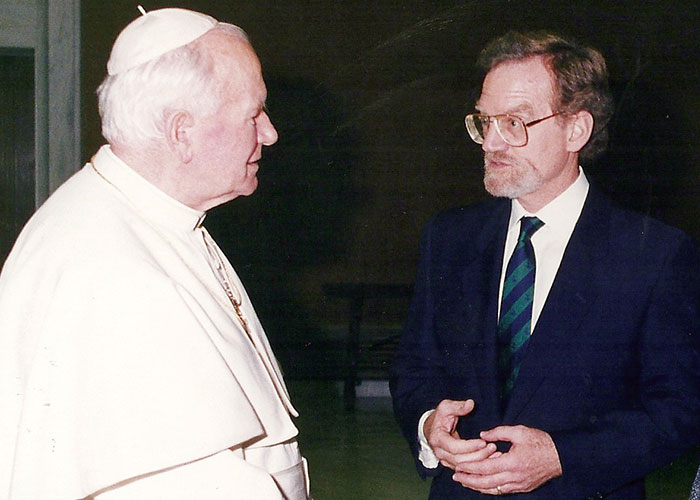
Pope John Paul II with the author.
Courtesy of James Creagan
It was almost midnight on Christmas Eve, 1989. My wife and I were nestled in the diplomatic section of St. Peter’s Basilica in Rome, looking forward to a long and tranquil Midnight Mass, when I received an urgent message: Call Washington immediately on the secure phone. I dashed back to the chancery and called the Operations Center.
Panama’s strongman, General Manuel Noriega, whom U.S. troops were seeking during “Operation Just Cause,” had entered the Vatican embassy (papal nunciature) in Panama City. I was told to tell the Vatican emphatically not to give him diplomatic asylum there. We wanted him for criminal offenses. Back to St. Peter’s I rushed, and tiptoed through a hushed basilica as the TV cameras followed.
I tapped the Vatican deputy foreign minister (a French archbishop) on the shoulder and gave him our curt message. Without the blink of an eye, the archbishop responded that the chief of state, Pope John Paul II, was up on the altar; the prime minister (Cardinal Casaroli) was seated with the diplomats; and the mass would be long. “Tell [President George H.W.] Bush and [Secretary of State James A.] Baker that they have about three hours to think. And don’t go in to get Noriega,” he said. I blurted that that was the last thing on our minds (although U.S. troops had already surrounded the Vatican nunciature).
I spent Christmas Day with Archbishop Sodano at the Vatican foreign minister’s residence behind St. Peter’s, where I emphasized that Noriega was a criminal who had been indicted in the United States and should be turned over to us. That point was driven home by Secretary Baker in a telephone call to Cardinal Casaroli. The Holy See demurred. The foreign minister bluntly told me that the United States was an “occupying power” under international law; therefore, Noriega could not be turned over to us. I emphasized that it would be dangerous to turn him over to a third party such as Cuba or Nicaragua.
Sodano underlined the Vatican view that the United States makes its policy based on four-year intervals, while the Holy See has to think in centuries. He then outlined reasons why President Bush and Secretary Baker should not be concerned about Noriega’s ability to cause trouble (we were worried about the possibility of some action of a guerrilla nature in the mountainous jungle areas). Noriega had been let into the nunciature, but would not get asylum. His phones were cut, he would be denied public contact and he had no rights. While the nuncio could not turn over Noriega to the United States, he might be induced to voluntarily walk out.
The next 10 days were full of classic diplomatic action by Ambassador to the Holy See Tom Melady, Political Officer Deborah Graze and me. At one point the Cardinal Secretary of State asked us to please turn off the rock music our military had blasting at the nunciature in Panama; the nuncio couldn’t sleep. After some urging—and suggestions by the Vatican that Washington appeared to have difficulty getting our military in Panama to stand down—the music stopped.
Coordinating public affairs was an issue. At first, the respective press spokespeople were mutually critical. We needed to work on a change in public posture. Cardinal Casaroli had the Vatican spokesperson talk of “serene cooperation” with the United States, while Marlin Fitzwater at the White House said that the Vatican was doing “a fine job.”
By Jan. 4, 1990, Noriega had had enough of living in the papal nunciature. With possibly menacing crowds outside in addition to those patient U.S. forces, he asked for his uniform and general’s cap and then walked out to meet U.S. officials. For those of us at the U.S. embassy to the Holy See, it had been 10 days of pure old-fashioned diplomacy—admittedly, backed by those troops in Panama. Diplomacy, with mutual interests at play, worked.
James Creagan spent three decades in the Foreign Service, serving in Peru, Mexico, El Salvador, Brazil, Portugal, Italy and at the Holy See. He was named U.S. ambassador to Honduras by President Bill Clinton in 1996. After retiring from the Service in 1999, he became president of John Cabot University in Rome, Italy.
Defeating Communism with Cars
EASTERN EUROPE, 1990s • BOB POWERS
In the late 1980s and the early 1990s, the countries of Eastern Europe were undergoing radical challenges to their governments. Democratic forces were rapidly organizing to defeat the communist-led dictatorships that had existed during the era of Soviet domination.
During much of this period, I served as director of the Regional Program Office in Vienna. RPO was responsible for providing public affairs support to our embassies in Eastern Europe and the Soviet Union. Naturally, communist governments in Eastern Europe were challenging the efforts of the newly forming democratic forces, which were sorely in need of help.
Considerable help was being provided from the United States. Nongovernmental organizations (NGOs) such as the Republican and Democratic parties, Freedom House, the George Soros Foundation and others were giving money to buy newsprint, audio/video devices, cars, ballot boxes and seals, and other needed equipment. RPO received an allotment increase of $150,000 from USAID to pay for copying equipment, computers, printers, the printing of ballot forms, election seals, bands and stamps. The cars and equipment were picked up in Austria by representatives of the non-communist parties, who drove them to their home countries.
Countries in need of help turned to RPO to provide guidance as well as active support for their efforts. In Bulgaria, for example, opposition leaders were sorely in need of transportation. Although nongovernmental funding was available, the vehicles themselves were impossible to procure in Sofia. Donors turned to RPO for assistance. Since speed was of the essence and non-governmental funds were being spent, I concurred with RPO’s executive officer, Johannes Schmiedt, that as long as no NGO funds passed through our hands, he did not have to apply strict governmental procurement rules, which would have delayed the process considerably.
The government controlled the sale of all newsprint in Bulgaria, thereby preventing democratic challengers from printing any newspapers presenting their views. —Bob Powers
Schmiedt and his assistant George Mathew worked with contacts in Germany, who bought used vehicles on the open market and had them moved to Vienna. They also arranged for local procurement of other equipment. Bulgarian representatives then picked up the cars and drove them to Sofia. No money ever passed through RPO’s hands in this unusual but effective procedure.
In Bulgaria, the government controlled the sale of all newsprint, thereby preventing democratic challengers from printing newspapers presenting their views. When RPO was asked to help procure newsprint, I immediately contacted Freedom House, which promised to provide the $70,000 needed for the purchase of newsprint from an Austrian paper mill. When we called to place the order, however, the mill demanded immediate payment. Since the funds were from an NGO and would take several days to reach the company, I asked if they would deliver the newsprint based on my personal guarantee—making me personally liable for the entire amount if Freedom House reneged.
The newsprint was quickly shipped to Bulgaria. And, of course, Freedom House came through with the money as promised. Subsequent orders of newsprint were purchased in Norway and shipped by rail to Bulgaria.
The herculean efforts of the RPO staff contributed considerably to the election of Zhelyu Zhelev, the first non-communist official elected to any leading position in the country in more than 40 years. During a trip to Sofia, President Zhelev expressed his enthusiastic thanks for all of the help the RPO staff had provided.
The presence and efforts of diplomatic employees made a tangible and lasting difference in Eastern Europe.
Bob Powers is a retired Senior Foreign Service officer who served in nine countries during a 35-year career.
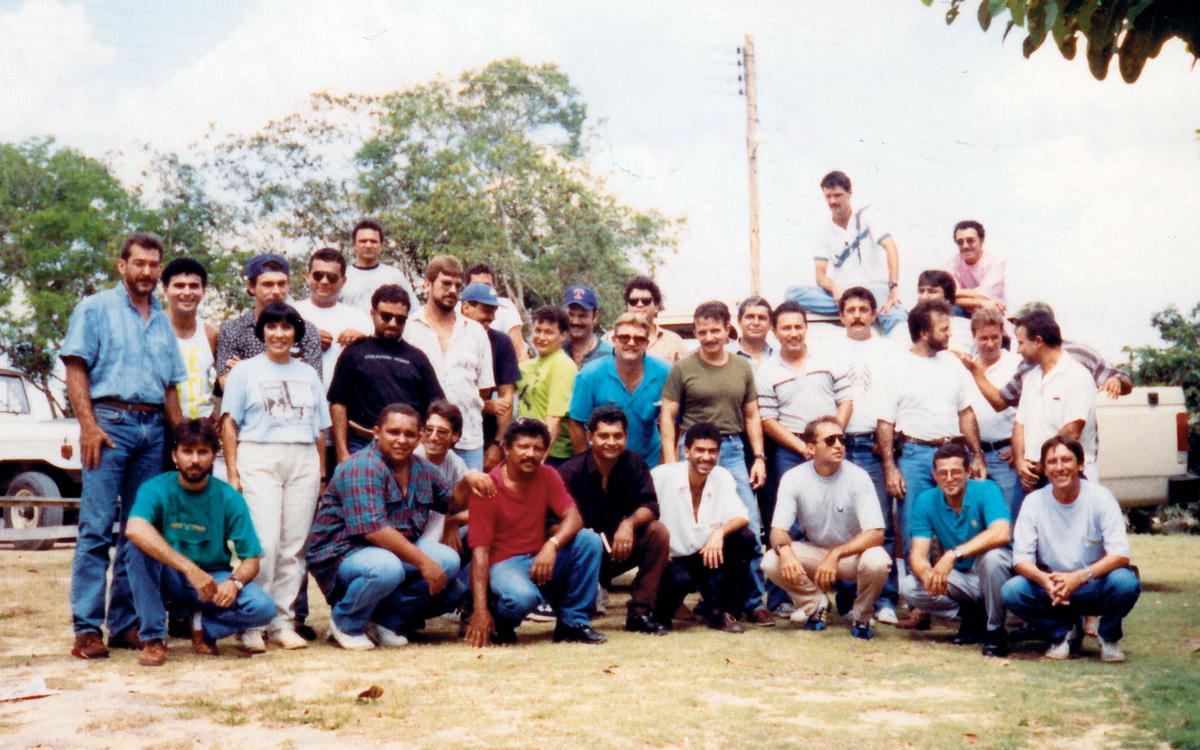
Norma Reyes, standing third from left, with members of the DPF/DRE boat units and the U.S. Navy training team.
Courtesy of Norma Reyes
“Essa Mulher” and the Counternarcotics Partnership
BRAZIL, 1992 • NORMA V. REYES
A Foreign Service narcotics affairs officer, I left Washington, D.C., in January 1992 to head the narcotics affairs section at U.S. Embassy Brasilia. I had been the Bureau of International Narcotics and Law Enforcement Affairs (INL) program officer for Brazil and the Southern Cone (Argentina, Uruguay, Paraguay and Chile) for more than a year.
INL funded the Southern Cone countries’ riverine or port projects, which were overseen by U.S. Coast Guard attachés. As they were part of my portfolio, I attended quarterly meetings on riverine and coastal projects hosted by General George Jowlan, commander of the U.S. military’s Southern Command in Panama. And as a member of the Riverine Steering Group, I became acquainted with the U.S. Naval Small Craft Instruction & Technical Training School (NAVSCIATTS), headed by Captain Harry Stanbridge.
At that time counternarcotics funding to Brazil averaged $4.5 million per year. Of that, about $700,000 was used by Brazil’s Federal Police Narcotics Division (DPF/DRE) annually to finance engine repairs by several Brazilian companies on 10 Boston Whaler fast boats and two Long John boats. Training members of the boat units in maintenance and effective boat handling could cut these repair costs significantly, freeing the money to be used elsewhere.
After arriving in Brazil, I contacted Capt. Stanbridge and informed him that I wanted his team to provide training for the Brazilian DPF/DRE boat units, but that it might take a while. I had several obstacles to overcome. The first was reluctance by the head of the narotics division to work with “essa mulher”—that woman. He lamented loudly that the embassy couldn’t assign a man to work with him, then assigned his third-in-command to deal with me.
But that was just one problem. The Brazilian military was not permitted to work in counternarcotics, so there were sensitivities about permitting U.S. military personnel to do so, much less to work on a domestic, non-military police project. Capt. Stanbridge assured me his team could travel on commercial flights, wear civilian clothes and report to me instead of our embassy military attachés. The military group commander, who had helped me liaise with the Southern Command, would be the emergency contact.
The next step was to get permission from the Brazilian government for the training project. Since my predecessors had worked only with the deputy minister of foreign affairs, I was directed to contact her. In our meeting, I emphasized the conditions Capt. Stanbridge had agreed to, assuring her that the team would have no contact with embassy military personnel. She was not willing to proceed, however.
I drafted a diplomatic note, signed by Ambassador Richard Melton, asking the minister of foreign affairs to allow me to work directly with the Ministry of Justice. While waiting for a response, I took a trip with my narcotics division counterpart and a U.S. Drug Enforcement Administration agent to the main towns and ports along the borders with Colombia, Bolivia and Peru, the three drug-producing countries ranged along two-thirds of Brazil’s western border. I wanted to introduce myself to DPF/DRE personnel and acquaint myself with the issues they faced regarding drug trafficking—one of several issues in their portfolio.
On return to Brasilia, we learned that the Federal Police director had promoted the head of the narcotics division—the same man who refused to work with “essa mulher”—to be his assistant. My fellow traveler, the third-in-command, would be the new head of DPF/DRE.
Soon thereafter, I was summoned to the embassy front office and handed a note signed by the Brazilian minister of foreign affairs allowing the narcotics affairs section to work directly with the Ministry of Justice. Within days, I received a signed letter of agreement allowing NAVSCIATTS to train the Federal Police boat units.
On July 10, 1992, U.S. Navy personnel arrived in Manaus to start the three-month training course on maintenance and efficient handling of the fast boats. At the end of the training, the deputy chief of mission and I traveled to Manaus for the training team’s presentation of certificates of qualification to the Brazilian Federal Police, Narcotics Division, Riverine Boat Maintenance Unit.
Our collaboration with NAVSCIATTS allowed the police boat units to travel further out from their docks, and to acquaint themselves with smaller towns along the Amazon and its tributaries, and other rivers along the vast border with the major drug producers. Repair costs decreased and narcotics affairs section funding was available to increase other counternarcotics initiatives, like prevention.
It was the beginning of a successful four-year partnership between our respective counternarcotics programs.
Norma Reyes retired from the Foreign Service in 2001 after 12 years with the Bureau of International Narcotics and Law Enforcement Affairs. Ms. Reyes worked for the Department of Labor before joining the State Department.
After the Quake
ECUADOR, 2016 • STACY J. SCOTT
On April 16, 2016, 10 short weeks after my arrival at post, a massive 7.8-magnitude earthquake struck the coast of Ecuador in the Province of Esmeraldas—just 110 miles from my apartment in Quito. President Rafael Correa declared a state of emergency as the country faced its worst natural disaster in 67 years, which had left nearly 700 dead and more than 16,000 injured.
Over the next few weeks, I supported the country team’s work to coordinate $6 million in official U.S. government assistance, working to plan trips to the affected regions and coordinating calls with assistance agencies. This type of heartache and devastation is hard to witness as a silent bystander, and I felt called to take action beyond my official duties.
I contacted the international nongovernmental organization Pan de Vida (Bread for Life) and volunteered to take part in their assistance efforts for the coastal towns of Manta, Chone and Bahia de Caraquez in my spare time. I went on two relief trips with Pan de Vida, bringing bottled water and food supplies to people in the coastal towns most affected by the disaster—the first assistance many people received.
I also supported embassy community efforts to donate needed supplies and participate in outreach efforts. I volunteered my time, put creative ideas into action for the good of others and forged bonds with the Ecuadorian people. It was heartbreaking to hear their stories—families fleeing their collapsing homes, only to realize that not everyone made it out. My limited Spanish improved as I worked with the Ecuadorians.
We laughed together (often about the Portuguese words I was working to cut out of my Spanish!), and we cried together (for the loss of family members who were gone in an instant). This was grassroots public diplomacy in action; these interactions, beyond being immensely personally satisfying for me, highlighted the importance of civil society work and promoted our American ideals.
Stacy Scott is a State Department office management specialist currently posted in Quito.
After the Coup: From Power Plays to Peacekeeping
CÔTE D’IVOIRE, 1999 • JAMES STEWART
For decades after independence, Côte d’Ivoire was a bastion of political stability and a regional economic power. But on Christmas Eve 1999, a military mutiny changed all that. U.S. Ambassador George Mu, a career FSO, insisted to General Robert Guéï, who had taken power in the coup, that the junta must uphold political and humanitarian rights and return quickly to civilian rule.
Yielding to diplomatic pressure and the voices of Ivorian society, the junta permitted elections in October 2000, but our independent monitoring found them seriously flawed. Gen. Guéï claimed victory over the only viable opposition candidate allowed to run, Laurent Gbagbo. Guéï dissolved the National Electoral Commission part way through the count, and proclaimed himself president.
Laurent Gbagbo insisted that he had won, and the partial polling results seemed to confirm that. Gbagbo called his loyal “democrats” into the streets to protect his victory, and tens of thousands from several political parties followed suit. After days of street fighting, in which several hundred died on all sides, Gbagbo declared himself president.
The vicious struggle for political power, overlaid with ethnic, religious and economic tensions, continued as it had since the mutiny.
Ethnic tensions pitted Ivorians from the south and center against mainly Muslim northerners. In the south, loyalist radicals spread hate speech while their militias destroyed property. Nativists accused Alassane Ouattara, a prominent northern Muslim (who had been prevented from participating in the 2000 election, but was later elected president), of destabilizing the country. Meanwhile, rebels completely suppressed dissent in the north.
Even worse, death squads were operating across the country. In Yopougon, the most populous sector of Abidjan, death squads killed 150 civilians; in Bouake, in the north, rebels executed 100 national police; and in one night our Reuters contacts counted 180 bodies of civilians with lethal gunshot wounds in Abidjan morgues. We knew who had likely perpetrated these outrages and reported what we knew to Washington. We also helped the British ambassador move a U.K. company’s 250,000 machetes out of the country as we realized what terrible weapons they can be.
This tangle of complex issues was explosive. And explode it did. In September 2002, an armed column emerged from the north aiming to take Abidjan. The Abidjan-based French Battalion stopped the advance on an east-west line across the country. Soon after, the Economic Community of West African States (known as ECOWAS) stationed peacekeepers across the line between the two sides, establishing a demilitarized zone (DMZ). On our several visits to Ghanaian and Beninois peacekeepers (two of the five countries represented), we saw how thin on the ground they were. Still, they kept the sides apart, even when Ivorian Army elements tried to penetrate the DMZ.
Reporting officers routinely put in 60- and 70-hour weeks to support the ambassador and keep Washington apprised of events essential to U.S. interests. —James Stewart
Dozens of episodes of machine gun fire, burning roadblocks and killings erupted, shutting down the country for days and keeping the situation fluid, difficult to track. We reduced embassy staff considerably and positioned military support next door in Ghana for a possible evacuation.
To make sense of all this, embassy officers hustled to speak with dozens of government officials; political parties; nongovernmental organizations, especially human rights organizations; the international press; businesses; United Nations agencies; and other embassies, especially the French. Our cocoa company contacts became invaluable sources in the volatile west toward Liberia, itself wartorn. “Contacts, contacts and more contacts” was our motto.
Reporting officers routinely put in 60- and 70-hour weeks to support the ambassador and keep Washington apprised of events essential to U.S. interests and to deliver formal messages from the United States to the host government. The political-economic section worked long and hard to compile thorough and honest annual human rights and religious freedom reports mandated by Congress, as well as the detailed yearly Investment Climate Statement—all part of the essential public record for future reference.
Seeing little progress on the many complex issues troubling Côte d’Ivoire, in January 2003 Ivorian political parties met in Paris to hammer out the Linas-Marcoussis Agreement, which established a government of national reconciliation to deal with disarmament, citizenship issues, amnesty and hatred in the media.
Implementation was neither smooth nor speedy. The ambassador’s seat on the LMA Monitoring Committee afforded insight into the thinking of other committee members, leaders from nearby countries who were, however, reluctant to criticize Gbago’s actions.
When reconciliation bogged down after some months, the ambassador told us that a United Nations peacekeeping operation was needed and to “make it happen.” My team researched whether Ivorians wanted peace and whether peace looked possible. Conversations with our various contacts across the capital and country indicated mostly positive responses to both questions. In the next five weeks, as pol-econ chief, I drafted and sent 27 cables assessing hopes and risks in the country.
Shortly after, in February 2004, the U.N. Security Council established a robust peacekeeping operation (PKO) to facilitate implementation of the LMA. Deep-seated differences remained, but we saw a significant payoff for the diligent diplomatic work of many as the PKO protected civilians, supported disarmament and monitored human rights. Political and social struggle continued, but the PKO reduced violence, saved many hundreds of lives and enabled political progress.
James Stewart is a retired Foreign Service economics officer whose overseas posts included Italy, Botswana, Niger, Côte d'Ivoire, Sierra Leone and Kenya.
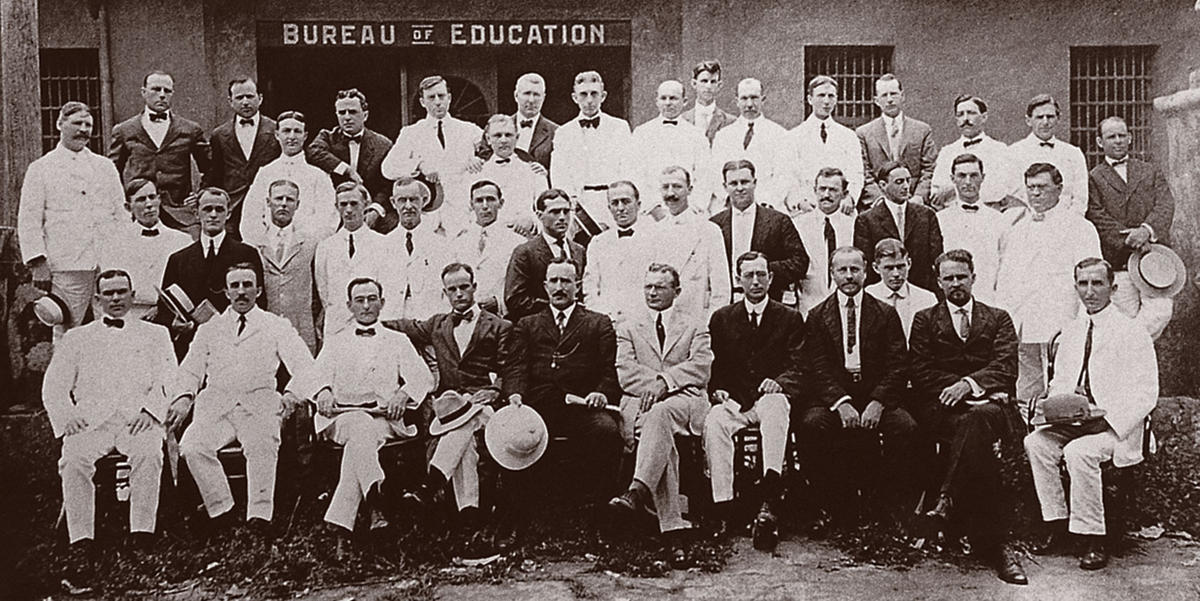
A group photo of early education officials and Thomasite teachers who were posted around the Philippine Islands, then a U.S. colony, by the new Bureau of Education.
GPS Manila / Rizal Library, Ateneo de Manila University
Before There Was a Peace Corps
PHILIPPINES, 2001 • MICHAEL ANDERSON
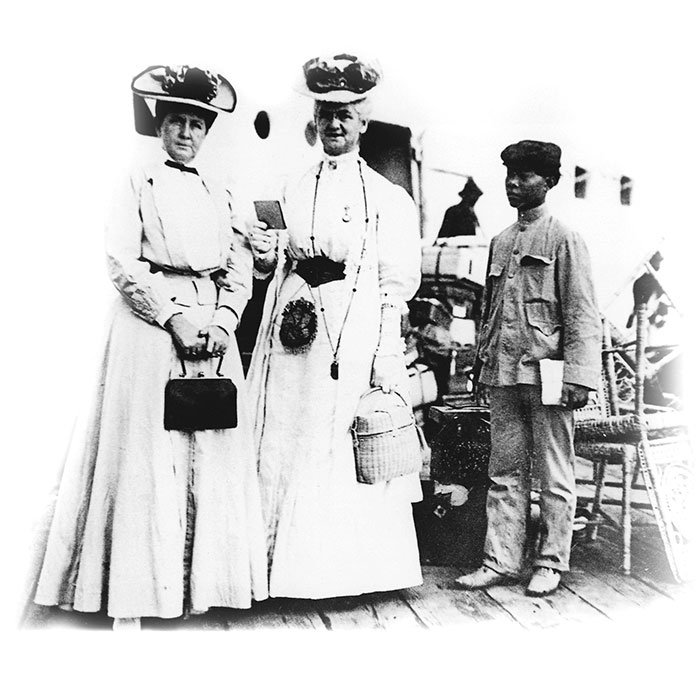
Two of the Thomasite teachers who journeyed to the Philippines starting in 1901 to establish schools.
GPS Manila / Rizal Library, Ateneo de Manila University
Everyone knows that the Peace Corps was founded in 1961 by President John F. Kennedy, right? Not quite.
The first time the U.S. government sent young, civilian volunteers overseas to promote development and mutual understanding was actually in 1901. That year the U.S. government, under President William McKinley, began sending volunteers to the newly acquired U.S. colony of the Philippines to establish a public school system after a long period of Spanish rule.
The 540 pioneering young educators, recruited from across America’s universities, sailed from San Francisco to Manila in August 1901 aboard the U.S. Army transport vessel Thomas—hence, their name, the “Thomasites.”
Like Peace Corps Volunteers in the Philippines and dozens of other countries decades later, the Thomasites were a hardy band of adventurous, idealistic individuals. Posted around the Philippine provinces to teach English, they established the precursors of today’s Department of Education and encouraged democracy and good citizenship that would lead to eventual independence. As one Filipino journalist concluded, “Life was never the same again” after the arrival of the Thomasites.
I learned their inspiring, largely untold story while serving as public affairs officer in Manila from 1998 to 2002. The year 2001 marked the Thomasites’ centennial, and the embassy implemented a nationwide, multimedia public diplomacy campaign to tell their story. The message focused on the far-reaching, positive effects of these early American teachers on building a new nation and fostering bilateral friendship and respect.
Working with local contacts and partners like the Philippine-American Educational Foundation (Fulbright Commission) and the American Historical Collection housed at Ateneo de Manila University, the public affairs section found and shared Thomasite material, much of which had been lost or undiscovered over the decades, and brought relatives of Thomasite students and collaborators together with scholars of the program.
Our section supported numerous efforts to highlight the enduring legacy of the Thomasites. But at the same time, we used the centennial to look ahead and stimulate dialogue about the future of education, including the Fulbright exchange program, and U.S.-Philippine relations. By talking about shared values and the Thomasite experiences, the embassy helped foster countless conversations about the positive U.S. presence in the Philippines.
The frequent feedback was: “This is a story of which both Filipinos and Americans can be proud.” The Thomasite Centennial Project’s many tangible results over a year include a 73-page history of the Thomasites, designed and printed at the State Department’s Global Publishing Solutions office in Manila. Both the cultural affairs office—under Cultural Affairs Officer Dr. Thomas Kral—and GPS were crucial to the success of the campaign. The GPS, for example, designed a special Thomasite logo and provided a range of other highly professional editorial and printing services promoting the centennial.
The Thomasite Project showed that public diplomacy does work. One clear indication that our campaign generated goodwill and caught public attention was that the embassy received the Philippine public relations industry’s prestigious annual “Anvil Award of Merit.” Another indication was that our various events and products were in great demand and generated positive buzz among diverse audiences and across generations, including many young Filipinos who had never heard of the Thomasites and were prone to dislike American colonial influences and close military cooperation.
All the Thomasites have long since passed away, but the people-to-people links they began and the spirit of friendship they fostered continue today. Our public diplomacy efforts to share their story have had a lasting impact on U.S.-Philippine relations. Diplomats, Peace Corps Volunteers, Fulbright scholars and development workers came to the Philippines later to establish new connections, but the foundation of much of their work can be traced to the Thomasites. Our project helped ensure that these remarkable American teachers will not be forgotten.
Michael Anderson, a retired public diplomacy FSO, had two assignments in the Philippines. He served as Embassy Manila’s assistant information officer from 1982 to 1985 and was the public affairs officer from 1998 to 2002.
Preventing War between Peru and Ecuador
PERU, 1981 • EDWIN G. CORR
On Jan. 22, 1981, a Peruvian Air Force helicopter flying above the Ecuadorean-Peruvian “truce border line” was fired on by Ecuadorean military units deployed on the Peruvian side of the border. I was serving as ambassador to Peru at the time, and knew this would create a serious risk of war between the two countries.
Spain had established a boundary line between the populations (audiencias) of Quito and Lima in 1563. After the wars of independence ended for Peru and Gran Colombia, this line was regarded as the border from 1822 to 1829, when Gran Colombia disintegrated into Ecuador, Colombia and Venezuela. The border dispute began when Peru rejected Ecuador’s claim as a successor to Gran Colombia’s territory and claimed land north of the 1563 line.
The truce line was established in 1936 during Peruvian-Ecuadorean negotiations under U.S. auspices, and was later included in the 1942 Rio Protocol between Peru and Ecuador, to which Brazil, Argentina, Chile and the United States were guarantors.
The protocol settled the 1941-1942 Peru-Ecuador War (in which Peru had occupied much of Ecuador), and seemingly “settled” the underlying boundary dispute until 1946, when a U.S. Army plane discovered a previously unknown river and watersheds that made part of the prescribed border line inapplicable. Contention resumed, and in 1960, Ecuador unilaterally repudiated the Rio Protocol.
In 1978, when I was Embassy Quito’s deputy chief of mission, military clashes at the border threatened to escalate, but the United States helped contain the conflict.
The Peruvian armed forces ousted democratically elected President Fernando Belaúnde Terry in 1968, and ruled for 12 years—expanding the military with the help of equipment, training and aid from the Soviet Union. Belaúnde was again elected president in 1980. He ruled effectively, but with one eye on the armed forces.
On that January 1981 morning, after the Peruvian helicopter was fired on, we knew the situation would grow worse. As the U.S. ambassador to Peru, I established a crisis operations center at the embassy with officers and staff of the State Department, other civilian U.S. government departments and agencies, and U.S. military personnel, all of whom worked with their local contacts to learn and influence what was happening.
I had numerous meetings and telephone conversations with the president and the foreign minister of Peru, along with other cabinet ministers and selected senior military officers. I was on a secure telephone with State Department senior officers and the country desk. DCM Jerry Lamberty and I approved continuous situation reports streaming to Washington and to our embassies in Quito, Brasilia, Bueno Aires and Santiago. I also informed and coordinated actions with ambassadors to Ecuador from the other Rio Protocol guarantor countries. Embassy personnel worked continuously the first day, first night and second day, gathering information. We made clear to all our contacts that the United States was opposed to war and wanted a peaceful resolution.
On my early morning return to the embassy, the Air attaché informed me that a few minutes before, instructions had been given to the Armed Forces to cancel attack plans. —Edwin Corr
On the second day, based mostly on talks with top civilian officials, we believed the danger of war was subsiding. I had reduced crisis operations to give officers needed rest when the Air Force attaché entered to report that the Peruvian Air Force had 100 pilots and crewmembers on standby, with assigned missions for attacks in Ecuador—launch orders were expected the next day. A political officer also arrived to inform me that a senior official of the Peruvian Foreign Ministry had telephoned his daughter, who was married to an Ecuadorean, telling her to get her family out of Quito for safety.
It was after midnight when I called the president’s military aide and asked to meet with the president about extremely dangerous actions by the Peruvian military. I brought the Brazilian ambassador with me to represent the guarantor countries.
President Belaúnde met us inside the presidential palace. He led us to a small chapel and asked that we kneel to pray for guidance and peace. We did. The meeting in his formal office was brief. He thanked me for my alert and assured us he would order the Armed Forces not to attack Ecuador.
As we departed the office, we saw Armed Forces Commander-in-Chief General Hoyos and other senior officers arriving. Clearly the president and his aide had gone to work after my call. On my early morning return to the embassy, the air attaché informed me that a few minutes before, instructions had been given to the armed forces to cancel attack plans. Pilots and crews were departing their bases.
U.S. diplomacy played a major, critical role in preventing a Peruvian attack that would have resulted in thousands of Ecuadorean deaths. War would have roiled and divided countries throughout the hemisphere, thus disrupting the security advantage of living in a relatively peaceful region.
Peruvian and Ecuadorean military units clashed again on the border in 1995. Once more, the United States, collaborating with the Rio Protocol governments and working through the Organization of American States, established a truce; finally, in 1998, Peru and Ecuador established an agreement on boundaries, ending the 150-year dispute.
Diplomacy is our nation’s most effective foreign relations tool (and by far the least costly in money and lives) for the protection and promotion of our country’s interests and security. Diplomats with well-established contacts and knowledge of the history, culture and language of a country are best able to calm tense situations early and be persuasive voices of reason.
Edwin G. Corr, a career FSO (1961-1990), was U.S. ambassador to Peru, Bolivia and El Salvador; deputy assistant secretary for international narcotics control; deputy chief of mission in Ecuador; and a Peace Corps regional director in Colombia. He also served in Thailand, Mexico and on various State Department desks. He was a captain in the U.S. Marine Corps and is a retired professor and administrator.
Slowing the Spread of HIV
CHINA, 2013 • DAVID COWHIG
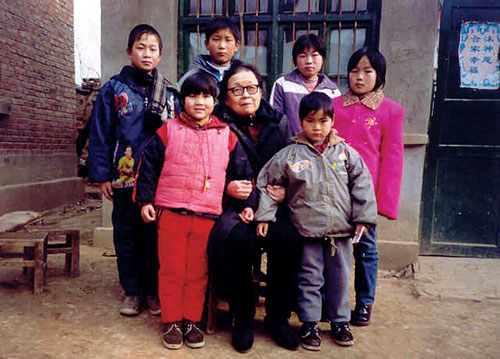
Dr. Gao Yaojie with AIDS orphans in rural Henan Province, China.
Courtesy of David Cowhig
During my five years in the science section at U.S. Embassy Beijing, with the strong support of science counselors Marco DiCapua, David Bleyle and Kurt Tong, my reporting on HIV/AIDS and public health in China helped the U.S. National Institutes of Health and the Centers for Disease Prevention and Control (CDC) work more effectively with Chinese partners fighting the HIV/AIDS epidemic.
Dangerous blood plasma collection methods at government blood banks in China had spread the virus to tens of thousands of people from 1994 onward. On the basis of internal reports done in 1995, China began requiring HIV testing of blood sellers, but reports documenting the unsafe practices of local authorities were kept secret. However, an outraged Chinese government official did share some of those secret reports with me at considerable personal risk. In 1997 official blood plasma collection centers using dangerous methods were closed, but some continued to run privately—and illegally—particularly in China’s most populous and most impoverished province, Henan.
Many Chinese public health workers, including many government and Communist Party officials, were frustrated by this state of affairs. Chinese journalists published stories about “HIV villages” in Henan province, where peasant blood sellers were dying of AIDS, leaving behind many orphans. Henan province physicians Wang Shuping, the first to speak out about the threat of HIV/AIDS in the blood supply, and her colleague Gao Yaojie campaigned to raise HIV prevention awareness and to help orphans whose parents had died of AIDS.
Dr. Wang had learned epidemiological skills from a CDC field epidemiology course taught in Beijing by Dr. Ray Yip in 1988. Employing those skills as a provincial blood bank worker, she was able to detect the spread of hepatitis C and then to predict the HIV epidemic. At the time, Henan blood plasma collection centers connected sellers of the same blood type to a tank that pooled their blood. Once the blood plasma was separated out using a centrifuge, the liquid fraction of the blood was pumped back into the blood sellers so that they could sell blood more frequently. Dr. Wang discovered that this dangerous practice was spreading hepatitis C, and she predicted that HIV would soon spread through the blood supply as well.
Dr. Wang spoke at many conferences of the Henan provincial health department, arguing that these profitable but dangerous blood collection methods would spread the HIV virus and must be stopped immediately. In response to her activism, the local authorities hired toughs to beat her up and had her fired from her job at the blood collection station.
Many Chinese health workers educated me about HIV in China and pointed me to Chinese books, media reports and medical journals that often hinted at more than they were allowed to say. The big picture is easy to censor, but nobody can fake all the details because it takes considerable background and study to know just what to fake. Chinese physicians, outraged by the cover-up, wrote articles in such a way that careful readers understood that things were more serious than was being disclosed.
Thanks to my skills in reading Chinese science and technology literature (I was a freelance science and technology translator before joining State in 1991), I was able to pick up many of these contradictions. At conferences foreigners were allowed to attend, I always sat with the Chinese, not with other foreigners, explaining, “It is more friendly this way.” I learned a lot from the whispered criticisms and commentary of the Chinese experts sitting nearby.
The official reporting cables I wrote helped Washington organize more effective cooperation on HIV/AIDS. Slightly sanitized versions of those U.S. Embassy Beijing reports, along with translations of Chinese articles, are still available on the embassy’s internet archive.
A Chinese official told me at the time that our online reports were being read in the office of the minister of public health, whose office thought our embassy reporting was excellent. Embassy reporting was picked up by The New York Times, The Washington Post and other media. Increased foreign attention, combined with growing public pressure from within China itself, seems to have helped accelerate Chinese government attention to HIV/AIDS and funding for HIV work.
David Cowhig is a retired Foreign Service officer who served in Beijing from 2007 to 2012.
The Making of Plan Colombia
COLOMBIA, 1999 • PETER ROMERO
It was early 1999, and we were set for takeoff on the American flight from Bogotá. Both of us sat in silence, unnatural for either Director of Andean Affairs Phil Chicola or me. We were stunned and trying to process what we had just seen and heard.
Security had deteriorated markedly throughout Colombia. Kidnapping, killing and extortion were becoming epidemic. If you could afford to fly between cities in the country, you did. Otherwise, you avoided driving beyond the city limits. Truckers, who had to drive, carried rolls of cash to make it through the many checkpoints manned by guerrillas and common criminals.
The country’s borders, particularly those with Hugo Chavez’ Venezuela, were not much more than signposts as guerrilla fighters, weapons, drugs and cash moved back and forth virtually unchecked. Cocaine and heroin production spiked. The annual CIA estimate reported that the guerrilla Revolutionary Armed Forces of Colombia (FARC) and National Liberation Army (ELN) coffers were approaching a billion dollars per year. Moreover, the daily visa lines outside our embassy were snaking around the block as the government of President Andrés Pastrana was losing its grip on huge swaths of territory.
Pastrana had been elected as the “Peace President” to follow through on his campaign pledge to negotiate an end to the 40-year conflict with the FARC and ELN. As a show of good faith for negotiations, Pastrana gave the FARC a despeje (safe haven) the size of New Jersey. In turn, the guerrillas used the despeje to recruit and train new fighters, including thousands of child soldiers, who swelled their numbers to about 20,000. The Colombian state was failing from its borders inward.
This was bad enough, but what left us speechless as we waited for takeoff were our briefings at the Colombian Ministry of Defense. After the perfunctory slide shows by the police and army chiefs—“Don’t worry, we’ve got this now”—we sat down with two U.S. special forces officers assigned to the ministry to put together all-source target packages for Colombian ops. We’d sat through a lot of these, but the briefings were particularly impressive, covering everything the Colombians would need to have and do to get the job done. It was all there, except offering to tie their shoes for them.
Then came the obvious question: How many of these target packages have you put together, and how many have they acted on? The junior of the two said that about two dozen had been passed to them. The senior officer sheepishly answered that the Colombians had acted upon two in the last year. He then went into why: there is little sharing or coordination among the many intelligence agencies and their operational components; they couldn’t get an airlift when needed; there is intense infighting between the police and army over who would lead; and so on.
Back on the plane, I turned to Phil, “We’ve got to do something, and it has to be big.”
“Yeah,” he said, “but this is going to be hard.”
He knew this better than anybody because his daily grind was to reply to the mountains of outrage leveled at State by Congress, the press, human rights groups and those within the Clinton administration who were justly incensed over the abuses by many in the Colombian army. Far worse, the army was turning a blind eye to the horrendous abuses of the paramilitaries, private armies supported by rural elites and ranchers. And, as Phil reminded me, getting an appropriation for this “big” package would take place in the midst of a presidential impeachment effort.
Yes, all that was true, but the situation was dire; our current assistance was hopelessly conditioned and fragmented. And there were key players in Congress who could be counted on. So we went to work. I reached for a pen, and Phil searched for paper. When he couldn’t find any, he reached into the seatback and pulled out the white barf bag. Good enough.
Phil had been my deputy chief of mission in El Salvador when our mission assistance was designed to support the peace accord, to reform or replace much of the government and the armed forces, and to provide the essential carrots and sticks for the guerrillas to disarm and demobilize. In El Salvador, the basic elements to assist in creating an enduring government presence beyond the capital (e.g., new police force, rural courts, infrastructure development, job creation and training, village banking, farmland, political party preparation) were all advanced under a peace agreement. In Colombia, their actions and our assistance had to get the guerrillas to the negotiating table, a very different panorama.
By touchdown in Miami we had a set of critical components for the big package. It contained all of the above and more (an all-service intelligence fusion center and a coca and poppy substitution plan), but it was also front-loaded with equipment and training for the military and police. We were mindful that security had to be the umbrella under which social, educational and health benefits would flow to war-weary rural dwellers.
At Colombian urging, the $1.2 billion initial budget request was dubbed Plan Colombia. We then set out to get the Europeans to pony up. Some 16 years and $12 billion later, the FARC signed a peace agreement with the government and the smaller ELN has begun talks. From the start, the Colombians owned Plan Colombia, raising more than twice our contribution through “security taxes.” The vision and statesmanship of its elected leaders made the difference.
The strategy’s success has made it a template for counterinsurgency worldwide. Colombian security and development specialists are found in Mexico, Central America and South America, and they have lent their expertise in Iraq, Afghanistan and beyond.
Rather than becoming a failed state next to the currently failing Venezuela, Colombia is at peace. Its people are at home working, and foreign investment is increasing at a brisk 15 percent per year. In August 2017, demand was four times higher than the offering of BBB-rated government bonds.
Plan Colombia’s success was the result of tireless efforts on the part of Under Secretary for Political Affairs Thomas Pickering and so many others at State; strong bonds of trust between our two countries; and superb bipartisanship through 16 years of Republican and Democratic administrations. But, more than anything, it was the courage of everyday Colombians, in uniform and out, who put their lives on the line for the sake of their homeland that made the 1999 tipping point a success.
It didn’t come either cheap or quick, but the policy worked.
During a 24-year Foreign Service career, Peter Romero served as ambassador to Ecuador, as chargé d’affairs in San Salvador and as assistant secretary of State for Western Hemisphere affairs under Presidents Bill Clinton and George W. Bush. He is credited with conceiving of Plan Colombia and was instrumental in convincing Congress to fund it. He currently co-produces a podcast, “American Diplomat.”





